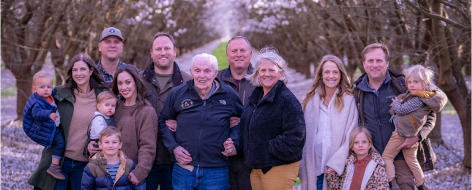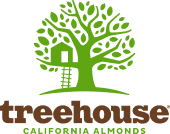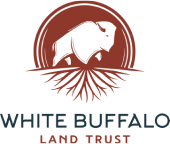The Almond Project
Advancing Soil Health for California Agriculture
Our Mission
The Almond Project is a multi-year, farmer-led partnership created to identify more sustainable farming methods and pave the way towards a more resilient future for almonds. By building a coalition of farmers, scientists, brands, technical service providers, processors, and customers, we’re implementing and testing a variety of soil health practices on almond farms in California. We’re measuring key outcomes across soil and ecosystem health, such as water holding capacity and infiltration, carbon sequestration, and ecosystem biodiversity in comparison to neighboring baselines. Our mission is to preserve natural resources, enable ecosystem regeneration, protect farming communities, and ensure the livelihood of nutritionally-rich almonds for generations to come.

Soil Health Practices
These practices aim to improve natural soil biology and fertility, sequester carbon, conserve water, and increase biodiversity.
Multi-Species Cover Crops
Cover crops can help prevent erosion, increase soil organic matter (SOM), improve soil structure, create habitat for beneficial microorganisms, and enhance water infiltration.
Animal Integration
Intentional inclusion of animals in cropping systems such as orchards can improve soil biology and fertility, increase biodiversity, and help manage cover crop and weed growth through grazing.
Increased Compost Application
Compost application has been shown to increase soil organic matter (SOM), microbial activity in the soil, and moisture retention. It can also allow for reduced inputs.
Input Reduction
Soil health-focused management principles in combination with the reduction of inputs such as synthetic pesticides, herbicides, and fertilizers can build ecosystem health and improve farm economics.
Soil & Ecosystem
Health Testing
Monitoring outcomes such as soil health, water infiltration, carbon sequestration, ecosystem biodiversity, and farm-level economics in comparison to baselines.
The Why

Almonds are a nutrient-dense, protein-packed superfood. But the climate crisis poses a dire threat to these nuts and the farmers whose livelihoods depend on them – especially in California, which supplies 80% of the world’s almonds.
We believe that healthy soil is key to the longevity of almond farming – but practical research is hard to come by, and the financial risk of testing and adopting new practices too often falls solely on farmers. Food companies have a responsibility to share the economic burden.

In the short term, The Almond Project aims to identify approaches to almond farming that improve soil health, increase biodiversity, and empower local farming communities. Longer-term, the program seeks to develop proof points to incentivize farmers and food companies to adopt practices that have the potential to regenerate California’s working lands, contribute to balancing our climate crisis, and enable the sustainability of farming in the Central Valley for generations to come.
The Founding Partners
We are a rare coalition of cross-functional advocates – farmers, scientists, brands, technical services providers, processors, and customers – working together to evolve the health of our food system.
Revolutionizing food design for people & our planet
Learn moreDelicious food built on real, unrefined fruits + vegetables that is good for you and the planet.
Learn moreSetting a new standard for frozen food.
Learn moreWe grow it. We slice it. We dice it. From our family to yours.
Learn moreRestoring Our Ecosystem through Agriculture
Learn more
New Partners

At Justin’s, we’re crafting delicious, real food products made with high-quality, mindfully-sourced ingredients that contribute to our world in a positive and meaningful way.
Learn moreOur Support Team
Geordy Wise
Senior Vice President Farming Operations, Pacific Ag Management
Cary Crum
Technical Assistance Partner, Agri Technovation
Dr. Jessica Chiartas
Soil Scientist, Soil Life Services
Lauren Tucker
Project Coordinator, White Buffalo Land Trust
Geordy Wise
Senior Vice President Farming Operations, Pacific Ag Management
Cary Crum
Technical Assistance Partner, Agri Technovation
Dr. Jessica Chiartas
Soil Scientist, Soil Life Services
Lauren Tucker
Project Coordinator, White Buffalo Land Trust
About The Program
What started as a five year research project has become so much more.
Learn about our research and new projects that we're embarking on in 2024 and beyond, below.
Commercial Scale Testing Blocks
- 160 acres soil health management practices
- 80 acres organic, 80 acres conventional
- 150 acres comparison blocks
- 75 acres organic, 75 acres conventional
Soil Health Practices
- Multi-Species Cover Crops: Multi-species cover crop mixes, including a diverse mix of legumes, grasses, brassicas, and non-legume broadleaves, were designed in partnership with our technical assistance partner to aid in the development of soil structure, increase soil organic matter (SOM), enhance water efficacy, build microbe habitat, and more. The seed mixes were developed with key goals in mind – fostering biodiversity on the conventional block and encouraging both biodiversity and nitrogen fixation on the organic block.
- Animal Integration: Sheep (ewes and lambs) are being rotated through the 160 acres of soil health management blocks in an effort to graze cover crop and weed growth, contribute to soil fertility, and increase biodiversity.
- Increased Compost Application: Manure compost from dairy cows has been applied throughout the 160 acres, to assist in increasing soil organic matter (SOM) and moisture retention, and develop microbial activity in the soil – all of which can aid in the reduction of inputs. The compost has been spread in bands over the tree rows to increase nutrient concentration over root systems.
- Input Reduction: Through implementation of the above practices, the team is working to reduce synthetic fertilizer and nitrogen applications as well as chemical disturbance such as pesticides, herbicides, and fungicides. The combination of these soil health practices and input reduction may improve farm economics and build ecosystem health.
Soil & Ecosystem Health Testing
Soil health is increasingly recognized as the underpinning of productive and resilient agricultural systems. As an emergent property of biological, chemical and physical interactions, the monitoring and evaluation of soil health requires a holistic, integrated approach.
- Soil Texture: Soil texture is considered a master variable of soil, as it has an overriding impact on how a given soil functions (i.e. ability to hold nutrients and/or sequester carbon) and is largely unchangeable by management. This inherent property represents the relative proportion of sand, silt, and clay sized particles in the soil.
- Soil Organic Matter (SOM): Soil organic matter is the component of the soil that consists of dead microorganisms and their byproducts, as well as decomposing plant and animal residues. While the ideal set of metrics for measuring soil health are still debated by the scientific community, there is consensus that SOM is the greatest indicator of overall soil health. SOM is about 58% carbon, as well as a storehouse of critical plant nutrients.
- pH: Soil pH is a measure of acidity or alkalinity. It is another “master variable of soil” and, while highly influenced by the inherent mineralogy (or parent material), it can be impacted by management over the long-term. It is a major determinant of nutrient availability, as well as microbial communities.
- Total Organic Carbon (TOC): Organic carbon exists in soil in the form of organic matter. It can be highly variable across a field and tends to change very slowly over time (decades or more), making it challenging to measure.
- Water Extractable/Available Organic Carbon (WEOC): WEOC is a measure of available organic carbon, or how much food/energy is available for microbes to fuel their work/activity. It is known as a key indicator of soil health, as it is sensitive to management and changes can often be measured long before changes in total SOM.
- Water Extractable/Available Organic Nitrogen (WEON): WEON measures the large, and often overlooked, pool of organic nitrogen in soil. It is a strong indicator of overall soil health, connecting biological and chemical properties that affect nutrient cycling.
- Potentially Mineralizable Carbon (PMC): PMC reflects not only the availability of SOM, but also the activity level of soil microbes. Depending on the size of the microbial community, high respiration is generally a good thing.
- Bulk Density: Bulk density represents the amount of solid soil particles (organic and mineral matter) relative to open pore space, where air and water can flow. It is measured as the mass per unit volume and is an indicator of how compacted or well-aerated a soil is. Compaction can restrict root growth/development.
- Nitrate/Ammonium: Plant available forms of nitrogen, which is a critical macronutrient for plant growth. Monitoring these pools is necessary for effective nutrient management. By minimizing excess applications of nitrogen, growers can reduce input costs, on-farm N2O emissions, nitrate leaching to groundwater, and nutrient pollution in runoff (and thus, eutrophication of waterways downstream).
- Phosphorus/Potassium: Phosphorus and Potassium are the other two macronutrients critical for plant growth. Monitoring is necessary for effective nutrient management and reducing excess input costs. Excess phosphorus can reduce the ability of plants to take up important micronutrients (like iron and zinc) and can also contribute to nutrient pollution in runoff water.
- Nutrient Analysis (Haney Test): This includes macronutrients (NPK), secondary nutrients (Ca, Mg, S), and micronutrients. Traditional nutrient analyses in the lab utilizes a variety of extracts to assess plant available nutrient levels, but can only provide rough estimates of what may be available to plants. The Haney Test, used here, is thought to provide a more realistic representation of nutrient availability in the soil.
- Aggregate Stability: Aggregate stability is the ability of soil aggregates to resist disintegration when exposed to rain or irrigation. Poor aggregate stability indicates a potential for pores to get clogged (leading to increased runoff and poor aeration), while high aggregate stability ensures water can infiltrate the soil and protects organic matter from being consumed by microbes.
- Water Holding Capacity: Water holding capacity is the amount of water that a given soil can hold for crop use. Soil texture, organic matter, and overall structure determine soil water holding capacity.
- Electrical Conductivity (EC): EC is a measure of salinity, or the amount of salts, in a given soil. While salts are important plant nutrients and critical for the flow of electricity in soils, excessive build-up of salts is a major challenge in California and other semi-arid regions.
- Leaf Tissue Analysis: This is a measure of plant nutrient levels that can provide early detection of limitations that could affect the subsequent crop.
- Almond Nutritional Analyses (protein & mineral): This analysis looks at the nutrient density in the almonds, as well as key antioxidants/flavonoids that are important to human health.
Ecological Outcome Verification
- We will test the adaptation of Ecological Outcome Verification (EOV), developed by the Savory Institute, to almond orchard growing systems.
- The trial of EOV on these almond orchards will serve as a vital resource to help establish a verification program for almonds and other perennial cropping systems.
*Ecological Outcome Verification (EOV) is an approach developed by the Savory Institute that measures and trends ecological outcomes on participating producers’ land. If results trend positive, a verification is granted and the farm is entered into the Land to Market Verified Regenerative Supplier Roster, which will, in turn, make it easier for food manufacturers to source and customers to purchase foods farmed using regenerative practices.
New Projects in 2024
In 2024 we are growing our coalition to take on new project work! These projects are currently in the process of beginning and seeking funding from our coalition members to complete.
Economic Modeling / Business Models
The aim of this work is to understand how it can be economically viable to sell almonds into the marketplace at a price point that companies and customers can afford, that at the same time incentivises land stewards of almond growing acres to tend to soils, biodiversity, and water and carbon cycles at their highest forms of health. Essentially, we will aim to figure out how our business models can support the transition of on-farm practices to meet these greater ecological goals that we hold in common. We will explore premiums, subsidies, long term contracts, and aim to find new ideas beyond these traditional models.
Trialing Certifications Beyond EOV
We are researching all the possible verification and certification programs that can certify “regenerative almonds” or “climate beneficial almonds”. Then we will trial a few to identify which programs will best serve all stakeholders in the supply system from farm, to processor, to brand, to retailer, and to customers.
Farm Practices Innovation Advisory board
We are forming a diverse group of almond farmers globally and technical assistance specialists for an advisory board that meets regularly. We will work together to creatively envision how almond growing can evolve with goals of biodiversity, efficient water use, carbon sequestration, chemical reduction, and soil health. We will produce a final report to explore what additional practices can be trialed in the future beyond cover crops, compost application, sheep grazing, and input reduction.
Nutrient Density Testing
We are working with a lab at UC Davis to compare the nutrient density of the almonds in the soil health blocks to the almonds in the traditionally farmed blocks. Samples will be taken from the 2023 harvest and 2026 harvest.
In the Press
Get in touch
For questions or additional information, please reach out to lauren@whitebuffalolandtrust.org .




